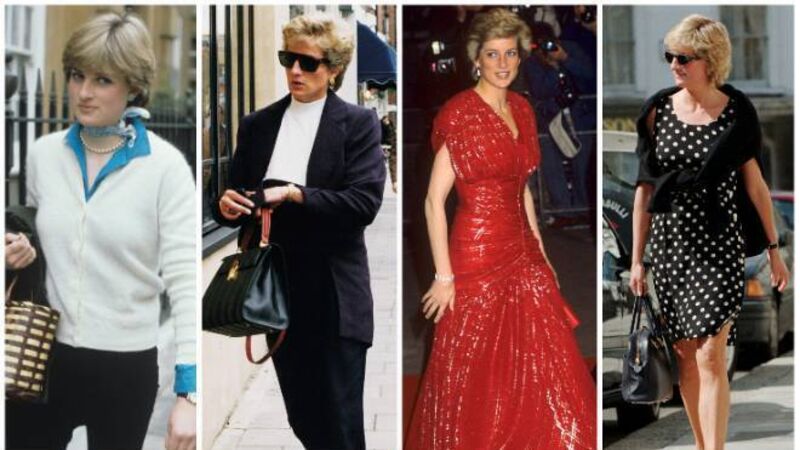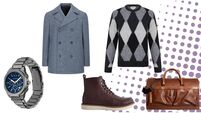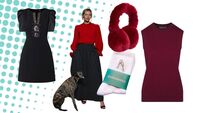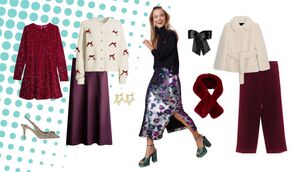Lady Diana's statement fashion - and the timeless appeal of 'revenge looks'

Some of the timeless looks rocked by Diana Spencer, former Princess of Wales
Eloise Moran has a passion for fashion, working as a copywriter for fashion brands since her early 20s. In 2018, the Londoner established the Instagram account @ladydirevengelooks, as a joke among friends following the collapse of her marriage when she was 25.
Little did she know that her tongue-in-cheek celebration of the fiercest post-divorce looks of Britain’s Princess Diana would garner 117,000 followers on Instagram and lead to her first book, The Lady Di Look Book: What Diana Was Trying to Tell us Through her Clothes, a joyful, irreverent, but empowering photographic catalogue of the style of the princess turned style icon.
Moran, 30, believes in the power of image to tell a story, something that Diana, the former princess of Wales, realised early in her life in the public eye. “I believe that clothes can tell a story and that many people underestimate the power of clothes,” says Moran. “I don’t think people realised that Diana was using her clothes as a weapon, and because they underestimated the power of clothes, they missed so many moments where she got the upper hand.”
Having watched the Netflix documentary Diana: In Her Own Words, Moran was gripped by the princess’s narrative. Finding parallels in her own life (albeit without the wealth, media scrutiny, and fame), she began researching photos of the princess, joking with friends about Diana’s “revenge outfits”. With her own wry break-up comments, she began captioning photos of the looks on Instagram, the same conversational style that characterises the Lady Di Look Book.
“When people think of revenge, they think of ‘bitter and twisted’, but I think that revenge is a natural part of healing,” says Moran. “I didn’t want the book to be too intense or angry — the whole point is to move on with life — so I wanted to make it lighthearted and funny, but still empowering.”

Her intention is not to rehash facts about the life of Diana, but to celebrate the strength and passion of a woman too often portrayed as vulnerable. “There are so many renderings of Diana that portray her as fragile and a little weak,” Moran says. The [2021 drama] Spencer went hard on her mental-health issues, but just because she had these issues doesn’t mean that she wasn’t a very strong person.”
“To me, she seemed quite sound of mind, just going crazy in a very intense situation. It’s almost like institutional gaslighting. I wanted to tell a story of the person I found inspiring and the person who (I’m not exaggerating) helped me get through my break-up.”
People of a certain vintage will love this technicolour romp through the looks of Diana. Chapters are devoted to covering everything from the princess’s naïve ensembles of pie-crust collar and jeans, through the polka dot and tartan era, to the sleek ‘revenge’ dresses of the early 1990s. But will younger readers respond to this ‘lookbook’ of a princess long ago?
“Years ago, our mothers were looking to Diana for inspiration, but now gen-Zs and millennials are looking to Diana,” Moran says. “I split the book into various chapters with different looks, because everyone can pull something from her style that resonates with them,” says Moran. “Fashion is cyclical, so I think the styles would have come around anyway, but during the pandemic Diana became a kind of athleisure star. She offered everyone an unintentional guide to pandemic dressing.”
Was Moran aware of Diana’s status in the fashion canon before she began her research, given that she was just five years old when the princess was tragically killed? “I was aware of her as a ‘style icon’, but my understanding of her was the flouncy 1980s pieces,” she says. “I began to research her, uncovering some of her 1990s looks, and thought, ‘This could be right now’!”

Moran sees Diana as a kind of early #MeToo figure: “Not in terms of sexual assault, but in terms of calling out men and speaking her truth, even though it put her in a position of great vulnerability,” she says. “After Charles’s admission of infidelity, instead of crawling under a rock, she made herself louder, which is what women have done in the last 10 years.”
However, Moran hasn’t written the book in light of the #MeToo movement or the resurgence in 1990s fashion: “I connected with her story and I believe lots of young people will connect to it, too. I’m a lot younger than many of the royal writers and I have a perspective that relates to more youthful attitudes around mental health, relationships, personal style, etc. Diana was ahead of her time: There is something about her which is so much more relevant to our generation than perhaps even my mother’s generation.”
Diana was a kind of proto-influencer. “I think from the day of her wedding, people realised that she was an influencer,” Moran says. “As she started to tour and appear in all these different looks, I think brands realised that she could be influential. It wasn’t a fast-fashion model in those days, but if Diana wore something, plenty of people would follow suit. She was the original influencer, though the term had not yet been coined.”
Social media and fast-fashion production mean that brands can respond instantly, but in Diana’s day, while some brands, such as kitsch knitwear label Warm and Wonderful (of the black sheep sweater) pivoted to demand, others, such as Sloppy Joe, did not see increased demand for their products.
This probably says as much about how we dress now as it does about the mechanics of the fashion industry: “The athleisure looks did not garner as much attention as her more glamorous looks at the time,” Moran says. “She also wore the same things over and over again to the gym, perhaps thinking that the paparazzi would leave her alone.
“No matter what date you search up there is a different outfit each day, so you realise just how often she was photographed. She was influencing fashion 30 years ago and is still doing that now. You go into any store and you can find Diana references everywhere, whether that’s the Sloane Ranger look, the athleisure look, or the Versace-esque bodycon dresses.”

Many of us associate Diana’s influence with the jewel-coloured ball gowns worn to 1980s debs. Moran says, however, that Diana is still influencing designers today, citing brands such as Shrimps and Allessandra Rich, as well as the Off-White Spring 2018 Natural Woman collection by the late Virgil Abloh, which included beautiful, tailored coats, voluminous dresses, and even one of the very same monochrome prints that Diana herself once wore.
“It was like ’80s prom style on crack with Diana,” says Moran. “Women cut their hair like her too. Some of the dresses she wore were pretty awful, but, in the context of the time, she was a tastemaker. You can still see how designers pull from even the craziest of those looks and turn them into something fresh and modern.”
The Lady Di Look Book takes the
reader through a kind of style evolution, from coy bachelorette to confident 30-something. This evolution runs, Moran says, in tandem with the evolving role of women in society.
“I think there was a time in the 1980s where Diana appealed to the British housewife and homemaker with the whimsical shirt collars, floral prints, and the pastel colours,” Moran says. “Then, in the 1990s, perhaps, she began to appeal to the working mum or ‘women on the move’. Obviously, in the 1990s there was that shift, where a lot more women were flooding the workplace and more mothers became working mothers.” There was an attitudinal shift, too: “She got a job and started to go to work every day. By the 1990s she was no longer in the shadow of Charles. She was taking her ambassadorial roles very seriously and she wanted to be taken seriously.”
The princess also graduated from puffy ball gowns to sleek, figure-hugging styles. “She obviously had a complicated relationship with her body, especially with the issues she went through with bulimia,” says Moran.
“According to her, she had her bulimia under control by the early ’90s, she got a personal trainer, and, as the restrictions on her loosened, I think she embraced that. She was dating, she was a single woman, and I think she started to appreciate her body and embrace her sexuality.”
There was definitely a shift from ‘Diana the princess’ to ‘Diana the international celebrity star’. Remember that dance with John Travolta at the White House in 1985? Or the stratospheric coup d’état the night after Prince Charles’s admission of infidelity in 1994? Diana stepping out of the car at the Serpentine Gallery dressed in the iconic Christina Stambolian “revenge” dress to uproarious applause and the front cover of every newspaper in the land the next morning? Many looks are covered in this book and they’re brilliantly illustrated, from Diana’s working uniform to her soccer-mom outfits, her Americana phase to her ski outfits, her 1990s power suits to her androgenous looks, a style that seems so current again. “Clothing is becoming more gender neutral and unisex, so I think there is a whole new relevance for these outfits now,” says Moran.

One of the final chapters — ‘The Mr Wonderful Revenge Look’ –covers Diana’s style while she was in a relationship with Pakistani surgeon Hasnat Khan. The evening of her divorce settlement, she attended a charity event at London’s Dorchester Hotel. She was wearing an ivory, pearl-embellished shalwar kameez by Pakistani luxury designer Rizwan Beyg. It was a hint to spectators and a nudge to Khan. “I often wonder if this rejection of British style and embracing a more international look, whether the USA sweatshirts, sexy Versace, or the shalwar kameez was another way of getting back at the royal family,” says Moran. “But Diana was a lover. I think she really loved Khan and wanted to be embraced by his family. I think she was showing her devotion to him by wearing some of these outfits.”
Diana’s commitment was not enough for Khan and they parted ways in 1997, the princess becoming reacquainted with Dodi Fayed a short time later. From the conservative shalwar kameez to the skimpy swimsuits she was photographed wearing on Fayed’s yacht, Diana was yet again sending out a message through her clothing. “She was very strategic and obviously wanted to send a message,” Moran says. “I look at those photos and think: ‘Good for her’. She was having an experience that any successful woman would have. Even though she tragically died shortly after those photos were taken, I think it gives people solace to have seen her so happy.”
For Moran, The Lady Di Look Book is about “Breaking free and truly discovering who you are, expressing yourself through your clothes and discovering how being more intentional with your clothes makes you feel about yourself. Ultimately, it’s about not letting the bastards get you down.”
When Moran first approached a literary agent with the idea, the agent said: “All I want is for you to write the book and get a divorce.” Inspired by Diana’s outfits and her kick-ass attitude, Moran has just used the last chunk of her book advance to hire a lawyer and file for divorce.
“In my mid-20s I was completely lost. I didn’t know who I was or what I liked. Five years on in my Diana journey, I have written a book and know that I want a career in writing. I think Diana can inspire people,” she says.
Amen to that.

- ‘The Lady Di Look Book’, by Eloise Moran, is published by Mitchell Beazley










